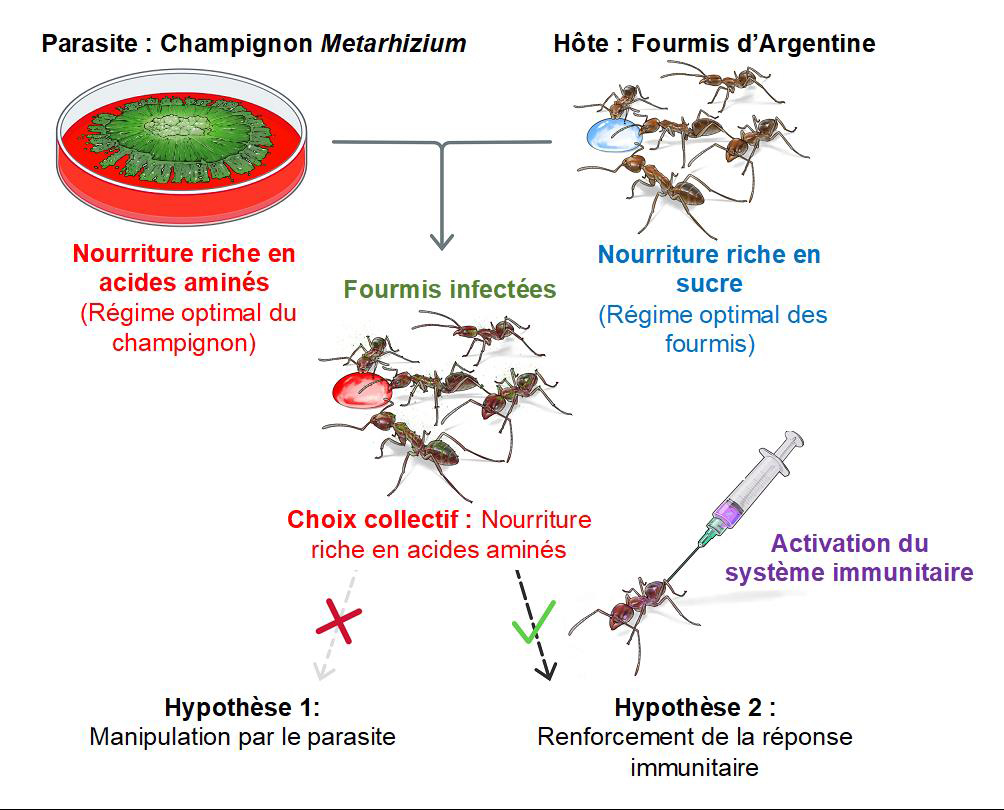Follow us on Google News (click on ☆)
Animals can fight parasites by modifying their dietary choices to boost their immune system. Conversely, parasites may manipulate the dietary choices of their hosts to obtain essential nutrients for their multiplication. Results published in the journal Current Biology reveal that dietary choice changes observed in ants infected by a fungus are not dictated by the parasite, but by a form of collective self-medication.

Figure: Fungus on the optimal diet rich in amino acids (top left), uninfected ants choosing a sugar-rich diet (top right), infected ants choosing the optimal fungus diet rich in amino acids (center), ant injected with inert fungal cells (bottom right).
© Sergio Ibarra & Audrey Dussutour
Nutrition is a major factor influencing host-parasite interactions. A parasitic infection has a nutritional cost to the host as activating the immune response to defend against a parasite is costly in amino acids (the building blocks of proteins). The host might, therefore, adjust their dietary choices to compensate for these amino acid needs. The parasite, on the other hand, has its unique nutritional needs. It might be inclined to manipulate the host's behavior towards food sources beneficial to it.
In this study, scientists explored the role of nutrition in a host-parasite system: the Argentine ant, Linepithema humile, and the entomopathogenic fungus, Metarhizium brunneum.
Nutritional Needs of the Fungus
The nutritional needs of parasites are poorly understood because it is often difficult to maintain them outside their host. First, the scientists sought to identify the optimal diet of the fungus by culturing it on 18 dietary regimes with different compositions (AA:S) in amino acids (AA) and sugar (S), from a diet containing half as much sugar as amino acid (2:1) to a diet containing two hundred times more sugar than amino acids (1:199). They established that the fungus maximizes its growth and reproduction on a diet relatively rich in amino acids (1:4).To see if the fungus can recreate this optimal growth diet from two unbalanced but complementary diets, they offered the fungus a choice between: a diet very rich in amino acids (2:1) and a diet very rich in sugar (1:199).
They observed that the fungus is capable of meeting its nutritional needs and maximizing its growth, revealing its ability to deal with complex nutritional challenges despite being devoid of a nervous system.
Nutritional Needs of the Ants
In a previous study, scientists had demonstrated that Argentine ants live shorter lives on diets rich in amino acids. In this study, they evaluated the survival of infected and uninfected ants on two dietary regimes: a sugar-rich diet (1:199) and the optimal diet of the fungus (1:4).Scientists confirmed that the more amino acid-rich optimum diet of the fungus drastically reduces the lifespan of uninfected ants as opposed to a sugar-rich diet (1:199). However, they demonstrated that the lifespan of infected ants decreases in response to the infection but is not affected by the dietary regime, with infected ants living as long on a sugar-rich diet as on the optimal diet of the fungus.
The scientists' hypothesis is that on the fungus's optimal diet, the toxicity of amino acids is neutralized by their use for the immune response.
A Collective Choice for the Optimal Diet of the Fungus
Next, scientists wanted to know what the dietary choice of colonies of infected and uninfected ants would be when faced with a sugar-rich diet (1:199) and the fungus's optimal diet (1:4). They found that uninfected colonies choose the sugar-rich diet, whereas colonies of infected ants choose the optimal diet of the fungus, even if the percentage of infected ants in the colony represents just 10% of the colony.The Ant or the Fungus: Who Decides?
Finally, to determine if the dietary choice of colonies of infected ants is the result of manipulation by the fungus to maximize its growth or a nutritional compensation by the ants to cover the energetic costs in amino acids of the immune response, the authors induced an immune response in ants in the absence of the parasite. To do this, they injected ants with inert fungal cells. They demonstrated that this injection and the parasitic infection both lead to the overexpression of genes involved in the immune response.They then revealed that ants injected with inert fungal cells choose the optimal diet of the fungus, just like the infected ants. These results attest that parasitized ants choose the fungus's optimal diet to strengthen their immune system and not in response to manipulation by the fungus. This study thus reveals a form of collective self-medication. Indeed, infected ants collectively choose a diet that has a long-term cost for the survival of uninfected ants but is beneficial in the short term for the immune response of infected ants.
Reference:
Csata E, Pérez-Escudero A, Laury E, Leitner H, Latil G, Heinze J, Simpson SJ, Cremer S, Dussutour A.
Fungal Infection Alters Collective Nutritional Intake of Ant Colonies
Current Biology.
DOI: https://doi.org/10.1016/j.cub.2024.01.017
The universe is "disappearing"
2 hours ago
The era of giant kangaroos that couldn't hop
3 days ago
A multitude of dark comets near Earth
4 days ago
How did our brain evolve?
4 days ago
The search for the Big Bang's echo begins
6 days ago
This 3D printer fits in your hand!
7 days ago
Behind the wrapping paper, perhaps a new physics
10 days ago
How does cornstarch flow through a pipe?
11 days ago
Discovery: PFAS are absorbed by human skin
11 days ago
The time: a quantum illusion?
12 days ago
More...